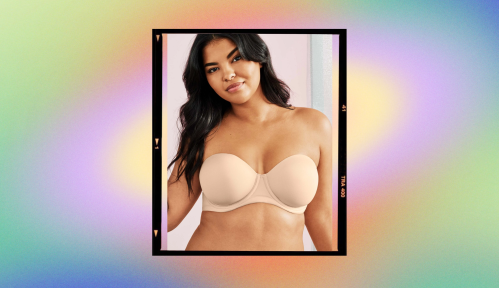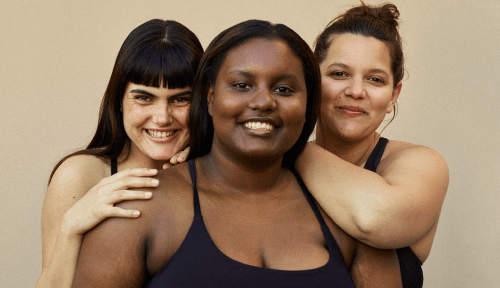Every time you hit *add to cart* on another flouncy midi dress or puff-sleeved top, do you ask yourself what materials your garment-of-the-minute is actually made from? Do you think about who made it, where, and how much she (because 80 percent of the time, it’s a woman) earned from your purchase? You’ve probably already envisioned exactly how you’ll style it, but did you also imagine how it’ll look in a landfill once that sartorial spark fizzles out?
It’s easy to get caught up in the bright hues and frilled cuffs of it all, hopping on fashion’s trend treadmill and hitting accelerate the minute we reach sale season. There’s a biological explanation for why this feels so good: Dopamine receptors are activated when we experience something new or exciting, and scoring a great deal on a pair of leather combat boots is no exception. Treasure in tow, you’ve become the king or queen of retail with the swipe of a credit card and it feels great. But what looks dazzling in your latest #OOTD post comes at an ugly price. The fashion industry is stained by the pollution, landfill waste, and human rights issues it perpetuates to keep consumers satisfied and spending. But the more we buy into it, the more our planet suffers.
“The levels of consumption in the global north are utterly unsustainable,” says Timo Rissanen, PhD, associate professor of fashion design and sustainability at Parsons School of Design. “There is an unimaginable excess of clothing being produced every year. Drastically reducing production and consumption is urgent.”
According a 2017 report, each year textile production creates an estimated 1.2 billion tonnes of carbon dioxide equivalent, or CO2e (a term for describing greenhouse gases that are not carbon dioxide but have the same effect on global warming). To put these numbers into perspective, that equates to more than the total CO2e produced from international flights and maritime shopping combined.
So does this mean we should stop shopping all together?
If you ask Rissanen, the answer is a resounding yes: “Some estimates suggest that in the global north we need to curb our consumption by 75 to 90 percent,” he explains. This means the most effective method for preserving and protecting our planet is to not buy anything new at all, which Rissanen himself did successfully from 2010 to 2012.
But if you’re not ready to drop the habit cold turkey (the term “shopaholic” had to come from somewhere, after all), there are alternative ways to adopt more conscious shopping practices. It starts with assessing your needs versus wants, and then understanding how to address those needs in a way that suits your lifestyle.
Option 1: Give your existing clothes new life
Lauren Bravo is a journalist and author who quit fast fashion for an entire year (which she chronicles in her book, How To Break Up With Fast Fashion). She points out that it’s difficult to prescribe one “correct” way of sustainable shopping due to the varying degrees of privilege, circumstances, and taste from one person to the next. But she does believe that rethinking our constant desire for newness—a dress for that wedding, an outfit for that interview, a sweater your friends haven’t already seen you in for brunch—is at the core of change. “If you feel ready for a shopping ban, they can be a really great way to hit ‘reset’ on our relationship with fashion, and challenge yourself to make the most of the clothes you already own,” Bravo says.
And she’s right. By keeping your existing clothes in use, you’re keeping them out of landfills, whether it’s by altering or repairing them for yourself or by handing them off to a different owner. “Re-familiarizing yourself with a sewing kit is a brilliant thing,” Bravo says. And if that doesn’t ease the sting of a fashion fast, there’s always the option to swap. “Just put the call out on WhatsApp and see what your friends are willing to lend,” Bravo suggests. “Swapping clothes on a grassroots level with your friends or local community is definitely one of the greenest, and most accessible—it’s free!—ways to get a new outfit.”
Option 2: Fall in love with pre-loved
Thrift and vintage stores are experiencing a resurgence of sorts both on and offline. What were once considered destinations for other people’s undesirable (read: smelly) cast-offs are now the ultimate meccas for closet creativity, especially for the style visionaries among us. Plus, nothing earns you wardrobe bragging rights like meeting a curious admirer’s inquiry about your elaborately decorated peasant blouse with the response: “Oh this? It’s vintage.”
According to ThredUP’s Resale Report, some projections predict that pre-owned sales could actually overtake fashion fashion over the next 10 years. “Of course, there’s an argument that vintage shipped around the world is less sustainable,” Bravo says. But if you’re buying locally donated items in person, you’re doing more than giving those garments a home and filling a gap in your wardrobe without acquiring something new. “We’re also helping to relieve the pressure of excess clothes donations stifling local textile economies overseas, which is currently a big problem because charity shops currently receive more donations than they can ever sell,” Bravo explains.
Places to check out if you’re looking to online thrift and buy re-sale? ThredUP, Re/Done (Verishop’s vintage category), What Goes Around Comes Around, and Open for Vintage.
Option 3: Rent, return, repeat
Millions of people have turned to borrowing garments for a relatively guilt-free way of skirting around the old outfit repeat issue. Clothing rental platforms like Rent the Runway have made it possible for shoppers to participate in a shared clothing economy by leasing the items they might otherwise only wear a few times. Retailers like Banana Republic (Style Passport) and Urban Outfitters (Nuuly) are even following suit by offering their own rental subscription services for the conscious consumer.
As popular as this alternative has become, it’s certainly not without its flaws. “Rental still has a few question marks,” Bravo says, acknowledging that factors like dry cleaning, shipping and returns, and the questionable future of rental pieces that have fallen out of fashion can mean more harm than good on the environment. Yes, you’re reducing clothing waste, but the carbon emitted to get that garment to and from your doorstep followed by the energy required to dry clean for the next gal can have major environmental impact.
Option 4: Make friends with new fabrics
You’ll need to study fashion’s budding green vernacular if you want to make choices that are actually kinder to our planet. You’ll also want to be able to distinguish between companies that are implementing sustainable, fair trade practices and reducing manufacturing waste from the brands hiding behind ineffective, top-line marketing jargon. “Words like ‘clean’ and ‘green’ do not mean anything,” Rissanen warns. Instead, do your research, don’t be afraid to go directly to a brand and ask questions, and follow the organizations campaigning for systemic reform in the industry like Remake and Fashion Revolution.
“Look at the fabric [your garment] is made from, see if it’s Global Organic Textile Standard (GOTS)-certified cotton or a sustainable alternative rather than normal cotton, polyester, or viscose,” Bravo advises. Become familiar with fabrics like Pinatex, a natural leather alternative made from pineapple leaves; Tencel, a cellulose fiber made from sustainably sourced wood pulp; and cupro, a fabric made from cotton waste. Keep in mind, though, that single-fiber fabrics are much easier to recycle than mixed fibers, so you’re better off opting for clothing that is 100-percent cotton, silk, or even polyester over a fabric blend.
At the end of the day, sustainability is simply not something we can buy. Curbing consumption across the globe is necessary if we’re going to collectively tackle climate change head-on. Still, for the instances where we are compelled to make a purchase, there are ways to do so thoughtfully. “We have to meet people where they are, and offer solutions that feel realistic and accessible to them,” Bravo says. “Nobody can do everything. But we can all do something.”
Sign up for the Well+Good SHOP Newsletter
Get exclusive deals on wellness, beauty, fitness, and food products that have been hand-picked by our editors.
Got it, you've been added to our email list.











